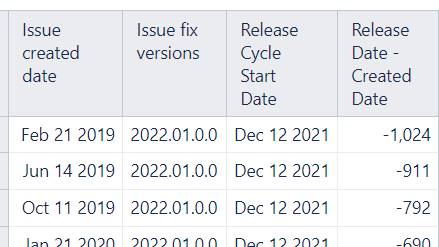I created 2 calculated measures, ‘Release Cycle Start Date’ and
The code for ‘Release Date - Created Date’ is:
CASE
WHEN CoalesceEmpty([Fix Version].[Version].getMemberNamesByKeys(
[Issue].CurrentHierarchyMember.get(‘Fix version IDs’),""))
MATCHES “2022.01.0.0”
THEN “Dec 12 2021”
WHEN CoalesceEmpty([Fix Version].[Version].getMemberNamesByKeys(
[Issue].CurrentHierarchyMember.get(‘Fix version IDs’),""))
MATCHES “2022.02.0.0”
THEN “Jan 23 2022”
ELSE “Jan 1 2030”
END
The purpose of this calculated measure is since our release values get inputed in the following format:
2022.01.0.0
2022.02.0.0
etc
I needed to convert these values to a date format so that I could compare them with another date format. So the calculated measure above basically assigns dates to these release values:
2022.01.0.0 > Dec 12 2021
2022.02.0.0 > Jan 23 2022
Then I created another calculated measure called ‘Release Date - Created Date’:
DateDiffDays([Measures].[Release Cycle Start Date],
[Measures].[Issue created date])
This calculate member simply subtracts the ‘Issue Created Date’ measure from the calculated measure that I created, ‘Release Cycle Start Date’. This part works. I’ll try to attach an image of this.

So when you do this subtraction ‘Release Date - Created Date’, some release dates will be after the created date (which will give a positive value) and some release dates will be before the created date (which will give a negative value). What we’re trying to find out is how many Jira tickets were created before the Release Date and how many were created after the Release Date.
What I need to do now is create a report that looks something like this:
Here, ‘Release’ is same as ‘Fix Version’.
My issue is in creating the calculated measures for the two following fields:
Count Issues Created BEFORE Cycle Start Date
Count Issues Created AFTER Cycle Start Date
For ‘Count Issues Created BEFORE Cycle Start Date’, I’ve tried the various combinations but can get none of these attempts to work. Your help would be appreciated.
NonZero(Count(
Filter(Descendants([Fix Version].CurrentMember
,[Fix Version].[Version]),
[Measures].[Release Date - Created Date]) < 0
))
NonZero(Count(
Filter(Descendants([Issue].CurrentHierarchyMemberMember,[Issue].[Issue]),
[Measures].[Release Date - Created Date]) < 0
))
Count(
Filter(
Descendants([Issue].CurrentMember, [Issue].[Issue]),
DateDiffDays([Measures].[Release Cycle Start Date],
[Measures].[Issue created date]))) < 0
NonZero(Count(
Filter(Descendants([Issue].CurrentMember,[Issue].[Issue]),
[Measures].[Release Cycle Start Date] -
[Measures].[Issue created date]) < 0
)
))
